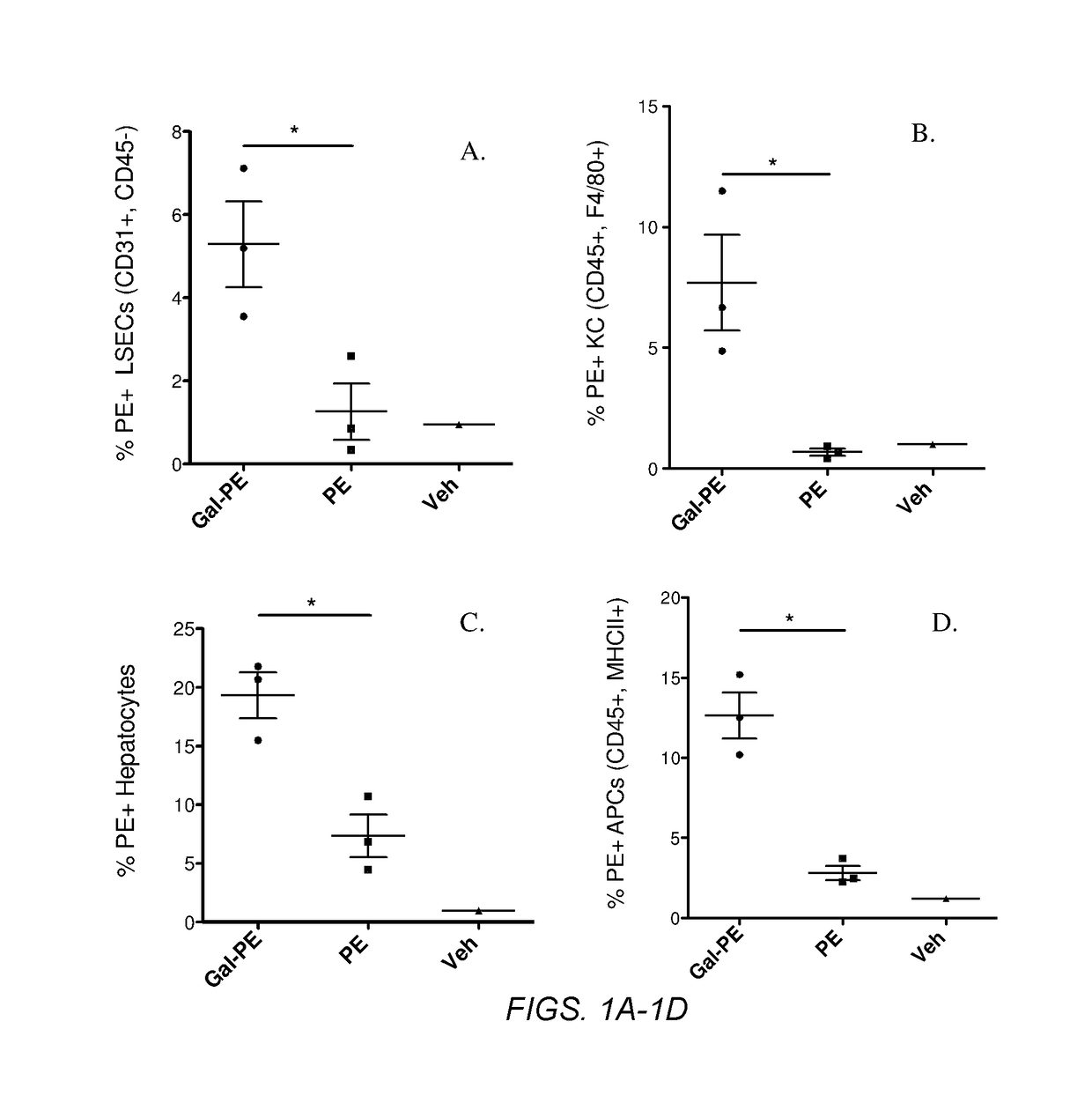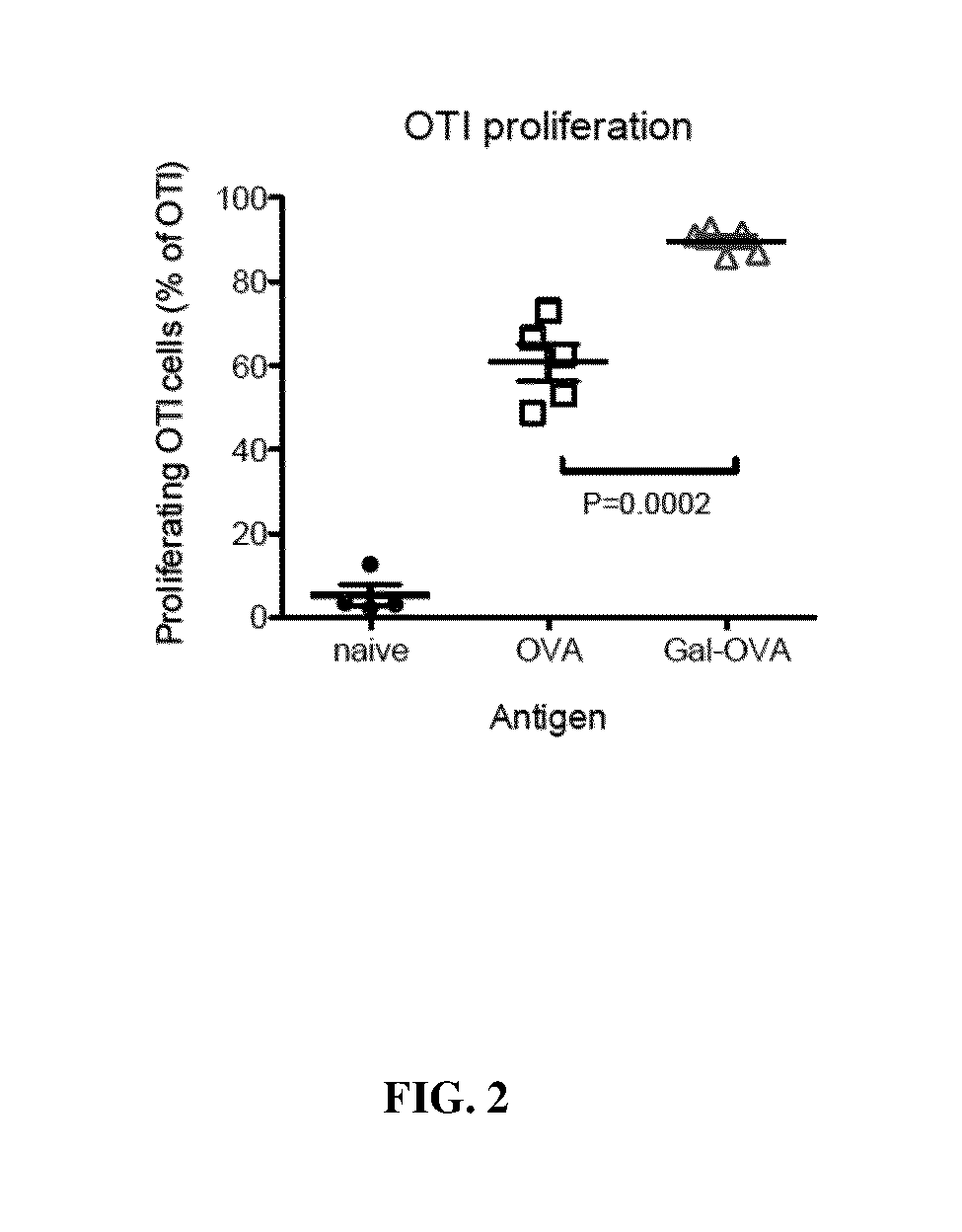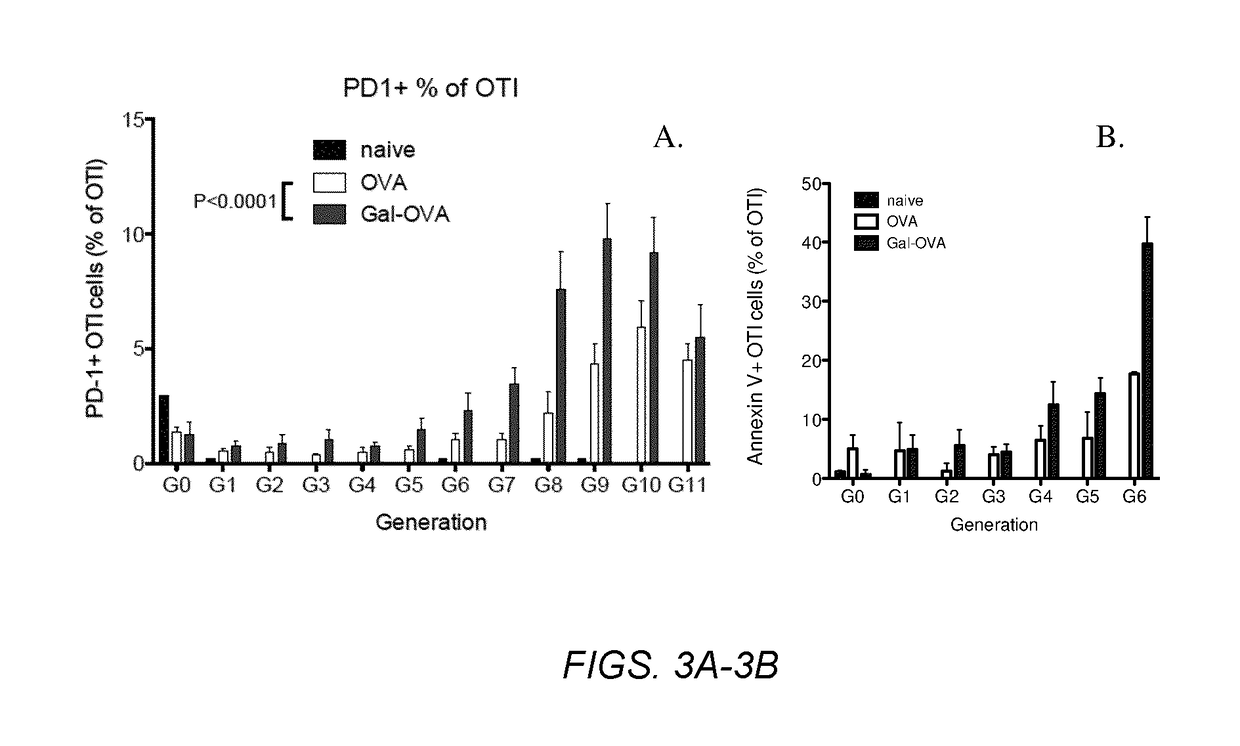Glycotargeting therapeutics
a technology of glycotargeting and therapeutics, applied in the field of glycotargeting therapeutics, can solve the problems of undesirable immune response from administration of such agents, failure to improve, and reduction, elimination or amelioration of adverse immune responses to antigens of interest, so as to reduce symptoms, reduce the effect of immune response, and elimination or amelioration of adverse immune responses
- Summary
- Abstract
- Description
- Claims
- Application Information
AI Technical Summary
Benefits of technology
Problems solved by technology
Method used
Image
Examples
example 1
F1aA-OVA-m4-n80 (or F1a-OVA-m4-n80-2NGAL)
[0623]1A. Formula 103′ where X′ is OVA and m is 4
[0624]In an endotoxin-free tube, OVA (5.0 mg, 0.00012 mmol) was added to 100 μl of pH 8.0 PBS containing κ mM EDTA and stirred. Separately, 1 mg of Traut's Reagent was dissolved in 100 μl of pH 7.0 PBS, and 16 μl (0.00119 mmol) of the Traut's Reagent solution so obtained was added to the stirred solution of OVA with continued stirring. After 1 hour, excess Traut's Reagent was removed using a centrifugal size exclusion column to afford the corresponding product of Formula 103′.
[0625]1B. Formula 106A where n is 80
[0626]In an endotoxin-free tube, galactosamine (10.0 mg, 0.04638 mmol) was dissolved with stirring in 100 μl of pH 8.0 PBS containing 5 mM EDTA. Pyridyl dithiol-poly(ethylene glycol)-NHS ester (Formula 104 where n is 80) (16.23 mg, 0.00464 mmol) dissolved in 100 μl of pH 7.0 PBS was added to the stirring solution of galactosamine. After 1 hour, the resulting pyridyl dithiol-poly(ethylene...
example 2
F1b-OVA-m1-n4-p34-2NAcGAL
[0789]2A. Formula 103′ where X′ is Ovalbumin and m is 1
[0790]In an endotoxin-free tube, OVA (6.5 mg, 0.000155 mmol) was added to 200 μl of pH 8.0 PBS containing 5 mM EDTA and stirred. Separately, 1 mg of Taut's Reagent was dissolved in 100 μl of pH 7.0 PBS, and 43 μl (0.00310 mmol) of the Traut's Reagent solution so obtained was added to the stirred solution of OVA with continued stirring. After 1 hour, non-reacted Traut's Reagent was removed using a centrifugal size exclusion column to afford the product of Formula 103′.
[0791]2B. Formula 1b where X′ is Ovalbumin, m is 1, n is 4, p is 34, R9 is a Direct Bond and Z″ is 2NAcGAL
[0792]In a micro centrifuge tube, poly(Galactosamine Methacrylate)-(pyridyl disulfide) (Formula 201) (20.0 mg, 0.0020 mmol) was solubilized in 50 μl of pH 8.0 PBS containing 5 mM EDTA. To this was added the purified OVA-Traut product from Example 2A followed by stirring for 1 hour. The resulting product of Formula 1b was purified by pass...
example 3
F1f-OVA-m1-n4-p33-2NAcGAL
[0839]3A. Formula 1f where X′ is Ovalbumin and m is 1, n is 4, p is 33, R9 is a Direct Bond and Z″ is 2NAcGAL
[0840]In an endotoxin-free tube, OVA (4.0 mg, 0.0000952381 mmol) was added to 0.1 ml of pH 7.4 PBS and stirred. Separately, poly-(n-Acetylgalactosamine)-p-nitrophenyol carbonate of Formula 601 where n is 4 and p is 33 (33.0 mg, 0.002380952 mmol) was added to 100 μl of pH 7.5 PBS and vortexed until dissolved. The two solutions were combined and the mixture was stirred vigorously for 1 hour. The mixture was then collected and dialyzed for 3 days against pH 7.4 PBS (30 kDa molecular weight cut off) to afford the product of Formula 1f.
[0841]3B. Formula 1f where X′ is Ovalbumin and m is 1, n is 4, p is 33, R9 is a Direct Bond and Z″ is 2NAcGLU
[0842]Similarly, by following the procedure of Example 3A and substituting poly-(n-Acetylglucosamine)-p-nitrophenyol carbonate for poly-(n-Acetylgalactosamine)-p-nitrophenyol carbonate, there is obtained the correspon...
PUM
| Property | Measurement | Unit |
|---|---|---|
| temperature | aaaaa | aaaaa |
| pH | aaaaa | aaaaa |
| temperature | aaaaa | aaaaa |
Abstract
Description
Claims
Application Information
 Login to View More
Login to View More - R&D
- Intellectual Property
- Life Sciences
- Materials
- Tech Scout
- Unparalleled Data Quality
- Higher Quality Content
- 60% Fewer Hallucinations
Browse by: Latest US Patents, China's latest patents, Technical Efficacy Thesaurus, Application Domain, Technology Topic, Popular Technical Reports.
© 2025 PatSnap. All rights reserved.Legal|Privacy policy|Modern Slavery Act Transparency Statement|Sitemap|About US| Contact US: help@patsnap.com



